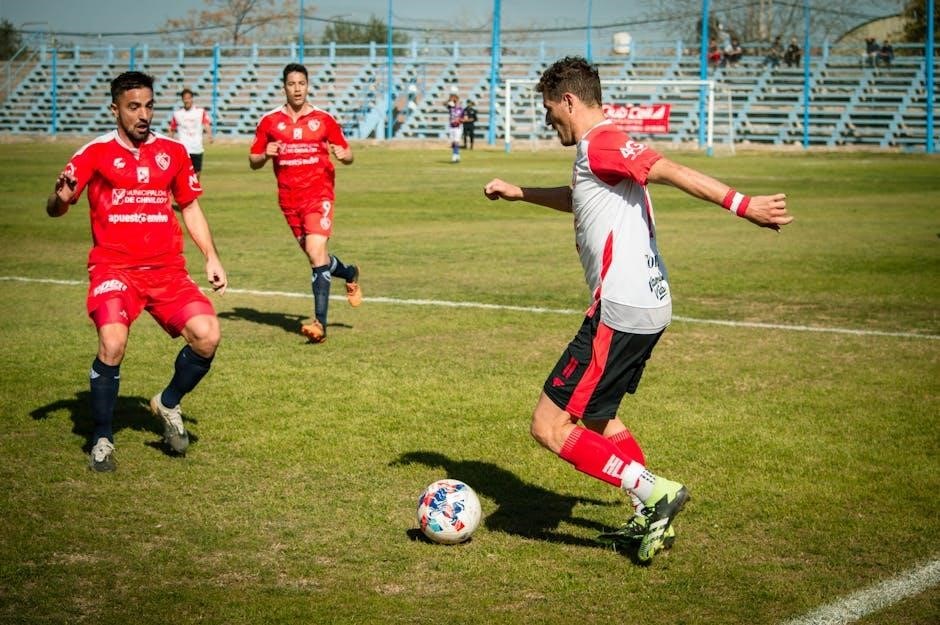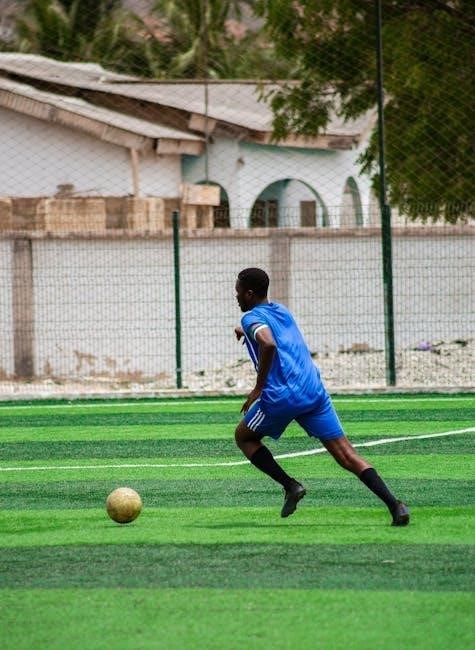Grip ball training is a simple yet effective method to improve hand strength, dexterity, and forearm endurance. It involves squeezing and manipulating a small ball.
1.1 What is a Grip Ball?
A grip ball is a small, squeezable tool designed to improve hand and finger strength. Typically made of rubber or plastic, it is used for exercises targeting grip strength, dexterity, and forearm endurance. Portable and versatile, it is widely used by athletes, therapists, and individuals for rehabilitation or strengthening purposes. Its compact size makes it ideal for daily practice, enhancing overall hand function and coordination effectively.
1.2 Purpose and Functionality
The grip ball is designed to enhance hand and finger strength, improving grip endurance and dexterity. It serves as a rehabilitation tool for injuries and a training aid for athletes. Functionally, it allows for various exercises like squeezing, pinching, and rotational movements, targeting the flexor and extensor muscles of the hand and forearm. Its versatility makes it ideal for both therapeutic and performance-enhancing purposes, ensuring comprehensive hand strength development.
Importance of Grip Strength
Grip strength is essential for daily activities and sports, enhancing overall functionality. It improves task performance and supports independence, making it vital for maintaining mobility and effectiveness.
2.1 Role in Daily Activities and Sports
Grip strength plays a crucial role in daily activities like holding objects, cooking, and typing, while also enhancing performance in sports such as tennis, rock climbing, and weightlifting. Stronger grip improves dexterity, reduces fatigue, and prevents injuries, making it essential for both functional tasks and athletic endeavors, ensuring better control and endurance in various physical activities.
2.2 Impact on Overall Performance
Strong grip strength significantly enhances overall performance by improving efficiency in tasks and sports. It reduces hand and forearm fatigue, allowing for sustained activity and better control. Enhanced grip also prevents injuries and boosts confidence, ensuring optimal execution in both daily activities and athletic pursuits. Consistent grip training can elevate physical capabilities, making it a key factor in achieving personal and professional goals effectively.

Benefits of Using a Grip Ball
Using a grip ball enhances hand strength, dexterity, and forearm endurance. It improves coordination and versatility, benefiting athletes, musicians, and individuals recovering from hand injuries. Compact and portable, grip balls are convenient for daily use, offering effective training for stronger, more capable hands in various activities and professions, boosting overall performance and reducing fatigue.

3.1 Physical Benefits
Using a grip ball strengthens hand muscles, improving grip strength and dexterity. It enhances forearm endurance, boosting overall hand function. Regular use improves coordination and reduces hand fatigue, benefiting activities requiring precision and power; The ball targets flexor and extensor muscles, promoting balanced development. This versatile tool supports rehabilitation, sports performance, and daily tasks, ensuring strong, capable hands for various demands.
3.2 Versatility for Different Users
Grip balls cater to diverse needs, making them suitable for athletes, musicians, office workers, and individuals recovering from injuries. Their portability and varied resistance levels allow customization for different strength levels. Whether for enhancing sports performance, aiding rehabilitation, or improving workplace ergonomics, grip balls offer adaptable exercises that can be tailored to meet specific goals and preferences, ensuring universal accessibility and effectiveness for all users.

Choosing the Right Grip Ball
Selecting the right grip ball involves considering size, material, and resistance level to suit your strength and goals, ensuring effective training and comfort during exercises.
4.1 Selecting Size and Type

Choose a grip ball that fits your hand size and strength level. Sizes range from 22cm to 30cm, with materials like PVC offering durability. Opt for textured surfaces for better control. Consider resistance levels: softer balls for rehabilitation and firmer ones for sports. Selecting the right size and type ensures comfort and effectiveness during exercises, catering to both beginners and advanced users.
4.2 Maintenance and Care Tips
Clean the grip ball regularly with mild soap and water to prevent dirt buildup. Avoid harsh chemicals or abrasive cleaners. Store in a dry, cool place to maintain shape and texture. Inspect for damage or wear and replace if necessary. Proper care extends the ball’s lifespan and ensures optimal performance during exercises and training sessions.
Basic Grip Ball Exercises
Start with simple exercises like squeezing the ball, wrist rotations, and finger pinches. These techniques improve grip strength and dexterity, perfect for beginners and daily practice.
5.1 Fundamental Techniques
Begin with full grip squeezes, holding 5-10 seconds, ensuring all fingers and the thumb engage. Practice wrist rotations, moving the ball in circular motions, and finger pinches, isolating each finger. Start with slow, controlled movements, gradually increasing speed and repetitions to build strength and coordination effectively. These techniques form the foundation for more advanced exercises.
5.2 Step-by-Step Exercise Guides
Power Grip Squeeze: Hold the ball in your palm, squeeze firmly for 5 seconds, then release. Repeat 10 times.
Pinch Grip: Place the ball between your thumb and index finger, squeeze gently for 5 seconds, release, and repeat with each finger.
Wrist Rotation: Roll the ball in your palm, moving your wrist in full circles, 5 times clockwise and counterclockwise.
Thumb Extension: Press the ball with your thumb, extending it away from your palm, hold 3 seconds, and release;
Ball Grip with Wrist Up/Down: Hold the ball, tilt your wrist down, then up, squeezing gently each time.

Advanced Grip Strengthening Techniques
Dynamic exercises and resistance training enhance grip strength. Techniques include progressive overload, varied grips, and timed holds to challenge forearm and hand muscles effectively.
6.1 Dynamic Exercises
Dynamic exercises involve active movement and resistance. Examples include rotational chops with a medicine ball, wrist flexion, and extension exercises. These movements target forearm muscles and improve grip control and endurance. They are essential for athletes and individuals seeking advanced hand strength. Regular practice enhances overall performance in sports and daily activities.
6.2 Resistance Training Methods
Resistance training with a grip ball enhances strength and endurance. Techniques include squeezing the ball against resistance, using both hands, and incorporating weighted balls. These methods build forearm muscles and improve grip power. They are ideal for athletes and individuals needing advanced hand strength for sports or occupational demands, ensuring better performance and durability in gripping tasks.
Grip Ball Exercises for Specific Needs

Grip ball exercises cater to specific needs like rehabilitation, sports, and occupational therapy, offering targeted routines for recovery or enhancing performance in particular activities.
7.1 Rehabilitation and Recovery
Grip ball exercises are highly suitable for rehabilitation, especially for stroke patients, arthritis sufferers, and those recovering from hand injuries. They offer gentle, progressive strengthening, improving dexterity and reducing stiffness. Simple routines like ball grip with wrist movements, pinch exercises, thumb extensions, and finger bends are effective for restoring hand function and promoting recovery.
7.2 Sports and Occupational Use
Grip balls are widely used by athletes to enhance performance in sports like weightlifting, rock climbing, and tennis. They improve grip strength, endurance, and control. Similarly, professionals with repetitive tasks benefit from these exercises, reducing the risk of injury and improving efficiency. Regular practice with grip balls ensures peak hand performance for both sports and occupational demands, making them an essential tool for many.

Incorporating Grip Ball into Daily Routine
Grip ball exercises can easily fit into daily routines. Perform hand squeezes, finger flexion, and pinching during breaks or while doing other tasks. Consistency is key.
8.1 Exercise Frequency and Duration
Aim to perform grip ball exercises twice daily, with 2 sets of 10 repetitions each. Start with short sessions of 5-10 minutes and gradually increase as comfort allows. Consistency is key for noticeable improvement in grip strength and dexterity. Incorporate exercises like hand squeezes, finger flexion, and pinching during breaks or while doing other tasks for optimal results.
8.2 Staying Motivated

Track your progress by noting improvements in grip strength and dexterity. Celebrate small victories, like increasing squeeze duration or performing additional repetitions. Incorporate grip exercises into daily routines, such as during work breaks or while watching TV, to maintain consistency. Sharing goals with a friend or using a tutorial guide can also help keep you motivated and engaged in your training journey.
Measuring Progress and Avoiding Plateaus
Regularly assess grip strength through squeeze tests and exercise performance. Track improvements in endurance and dexterity. To avoid plateaus, vary routines by introducing new exercises or increasing resistance levels.
9.1 Tracking Improvement
Monitor progress by counting repetitions, duration of squeezes, and resistance levels. Track improvements in grip strength and dexterity over time. Use a journal to record exercise frequency and intensity. Notice enhanced endurance and reduced fatigue in daily activities. Adjust routines based on performance to ensure steady growth and avoid stagnation. Celebrate small achievements to stay motivated.
9.2 Varying Workout Routines
To prevent plateaus, incorporate different grip ball exercises like full squeezes, finger pinches, and thumb extensions. Introduce varying resistance levels by using balls of different textures or sizes. Alternate between dynamic and static holds, and include wrist rotations. Mix up the tempo of squeezes, from slow to rapid, to challenge muscles differently. Rotate through exercises weekly to keep workouts engaging and effective.

Common Mistakes to Avoid
Over-squeezing, improper hand positioning, and ignoring rest periods are common errors. Ensure proper technique to avoid injury and maximize grip strength gains effectively always.
10.1 Proper Usage Techniques
Proper technique involves maintaining a balanced grip, avoiding excessive force, and keeping wrists neutral. Squeeze the ball slowly, hold briefly, and release gently to prevent strain. Ensure full hand engagement, focusing on both flexor and extensor muscles. Consistent, controlled movements enhance grip strength and dexterity while minimizing injury risks. Proper form is essential for effective and safe grip ball training.
10.2 Injury Prevention Tips
To prevent injuries, always warm up before training and use a ball size appropriate for your hand. Avoid overexertion and start with light resistance. Focus on controlled movements rather than extreme pressure. Gradually increase intensity to avoid strain. Listen to your body and rest if discomfort occurs. Proper technique and balanced grip are essential to prevent finger or wrist injuries during grip ball exercises.
Grip Ball Tutorial PDF Resources
Grip ball tutorial PDFs offer comprehensive guides, detailed exercises, and expert tips. They provide step-by-step instructions for improving grip strength and dexterity through targeted routines and techniques.
11.1 Finding Reliable Guides
Reliable grip ball tutorial PDFs can be found through reputable sources like fitness websites, physical therapy portals, and academic journals. Look for guides endorsed by professionals, offering clear instructions and images. Peer-reviewed articles and user-recommended resources are ideal. Ensure the PDFs include variations for different skill levels and purposes, such as rehabilitation or sports training, to cater to diverse needs effectively.
11.2 Effective Use of Tutorials
Using tutorials effectively involves following clear instructions and visuals to master grip ball exercises. Start with basic techniques, ensuring proper form to avoid injury. Gradually progress to more challenging exercises as strength improves. Consistency is key; practice regularly to see noticeable results. Tutorials are ideal for fitness enthusiasts, athletes, and individuals recovering from injuries, offering structured guidance for optimal grip strength development and dexterity enhancement.
Grip ball training enhances hand strength, dexterity, and forearm endurance, benefiting daily activities and sports. Consistency and proper technique are key for lasting results and injury prevention.
12.1 Summary of Benefits
Grip ball training enhances hand strength, dexterity, and forearm endurance, benefiting daily activities, sports, and rehabilitation. It improves grip strength, reduces injury risk, and boosts overall hand function. Versatile for all users, it’s ideal for musicians, athletes, and individuals recovering from hand injuries. Regular practice promotes better performance in tasks requiring grip control and contributes to long-term hand health and productivity.
12.2 Encouragement for Consistent Practice
Consistency is key to achieving lasting results with grip ball training. Even short daily sessions can significantly improve hand strength and dexterity. Stay motivated by tracking progress, incorporating exercises into your routine, and celebrating small milestones. Over time, regular practice will enhance performance in sports, work, and daily tasks, making it a worthwhile investment in your overall well-being.



0 Comments